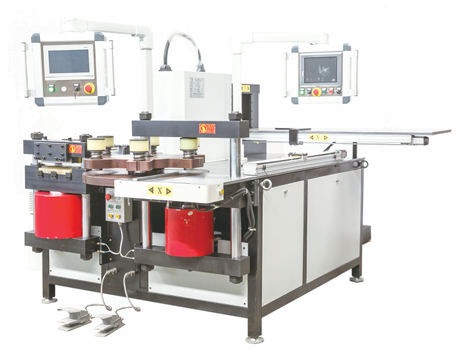Intelligent Solutions for Busbar Processing Challenges and Productivity Enhancement
In the power equipment manufacturing industry, CNC busbar punching and shearing machines have become essential core equipment for high-low voltage switchgear and transformer manufacturers. Faced with a variety of busbar processing equipment on the market, how to choose a CNC busbar punching and shearing machine that suits your production needs? How can you maximize the equipment's efficiency? These are practical challenges many engineers and business managers encounter. This article provides a comprehensive understanding of the technical details, selection points, and practical skills for CNC busbar punching and shearing machines, helping you gain a competitive edge in the busbar processing field.

CNC Busbar Punching and Shearing Machines: Beyond Simple Punching and Shearing
A CNC busbar punching and shearing machine is intelligent equipment specifically designed for processing copper and aluminum busbars. It precisely controls punching, shearing, and other processing procedures through a CNC system. Compared to traditional busbar processing equipment, CNC models offer qualitative improvements in processing accuracy, production efficiency, and automation levels. In modern power equipment manufacturing, it has become essential equipment in industries such as high-low voltage switchgear, substations, busway systems, and electrical switch complete sets.
A high-performance CNC busbar punching and shearing machine typically integrates multiple processing units, including basic functions like punching, shearing, and bending. Through simple die changes, it can also perform various special processes such as embossing, flattening, and pressing cable connectors. This multi-functional design significantly expands the equipment's application range, allowing enterprises to flexibly meet diverse production needs.
Core Technology Analysis: From Mechanical Structure to Intelligent Control
The turret-type punching system is a hallmark of high-end CNC busbar punching and shearing machines. This system uses an integrated turret made of ductile iron material, with multiple die positions on the turret. The die mounting holes are precision-machined by CNC machining centers, ensuring extremely high fitting accuracy. In superior equipment, the clearance between the die and turret can be controlled within 0.00-0.03mm. This precision design greatly improves die concentricity, extends die service life, and eliminates the need for frequent die changes during production, significantly enhancing work efficiency.
The shearing unit design directly affects processing quality. Modern CNC busbar punching and shearing machines mostly adopt high-precision double-column linear slide rail double-blade shearing structures. The upper and lower blades are installed vertically and parallel, ensuring clean, burr-free cuts without producing waste material. This design avoids subsequent grinding processes, saving enterprises time and labor costs. For businesses that need to process large volumes of busbars daily, this is particularly important.
The CNC system is the brain of the equipment, determining its level of intelligence. Advanced CNC busbar punching and shearing machines use well-known brand CNC systems, such as Panasonic, enabling complex functions like CNC angle calculation, Z-bend calculation, unfolded length calculation, angle compensation, inertia compensation, and pressing maintenance. Large color displays with intuitive graphical interfaces make operation simpler and more convenient, allowing even new employees to operate independently within a short time.
The hydraulic system performance directly affects equipment stability and service life. High-quality CNC busbar punching and shearing machines use hydraulically welded thick steel plate oil tanks treated with phosphating to prevent hydraulic oil from deteriorating over time. Oil cylinders use international standard cylinder materials to avoid oil leakage after long-term use. Hydraulic hoses use national standard Type A connections, which are durable and easy to maintain. These detailed designs ensure long-term stable operation of the equipment.
How to Choose the Most Suitable Model Based on Enterprise Needs
Considering processing material specifications is the primary factor in model selection. Different enterprises process vastly different busbar specifications, requiring equipment capacity selection based on the thickness and width of commonly processed materials. Mainstream CNC busbar punching and shearing machines typically offer processing capacities up to 12mm thick and 160mm wide, while heavy-duty equipment can even handle busbars up to 16mm thick and 250mm wide. If an enterprise primarily produces small switchgear, a compact model with a worktable size of 1230×900mm may suffice. For large substation projects, large equipment with an X-axis travel of 1200mm and Y-axis effective travel of 950mm is required.
Evaluating production efficiency requirements relates to enterprise capacity and benefits. For enterprises with fast production rhythms and large order volumes, priority should be given to turret-type multi-station models. This equipment is equipped with multiple punching dies, shearing dies, and embossing dies, enabling automatic die selection and positioning, significantly reducing die change time. For enterprises with heavy production tasks, models where three processing units are controlled by three separate pump stations can be selected, allowing simultaneous operation of punching, shearing, and bending units, maximizing equipment utilization.
Analyzing equipment accuracy requirements is key to ensuring product quality. The high-low voltage switchgear manufacturing industry has extremely high requirements for busbar processing accuracy. High-quality CNC busbar punching and shearing machines can achieve positioning accuracy of ±0.1mm and hole spacing control accuracy within ±0.10mm per meter. For ordinary application scenarios, equipment with punching accuracy below 0.05mm is sufficient. When selecting models, enterprises should choose machines with appropriate accuracy levels based on their product precision requirements, avoiding both over-investment and insufficient accuracy.
Considering equipment reliability and after-sales service is important for ensuring production continuity. As key production equipment, the reliability of CNC busbar punching and shearing machines directly affects enterprise delivery capabilities. When selecting, attention should be paid to the brand and quality of core components such as motors, oil pumps, solenoid valves, electrical components, linear guides, and ball screws. Simultaneously, the supplier's after-sales service response speed is crucial. Quality suppliers provide timely technical support and parts supply, ensuring quick recovery when equipment fails.
Safety Operation Regulations for CNC Busbar Punching and Shearing Machines
Pre-operation preparation is the first step to ensuring safety. The oil tank must be filled before starting for the first time to prevent damaging the oil pump. Operators must thoroughly read the user manual to familiarize themselves with the machine's structure, performance, and operation methods. If the ambient temperature is below 0°C, the machine should be idled for a few minutes before work.
Safety measures during operation are crucial. Never place hands or any part of the body between the upper and lower dies (blades) during operation to prevent accidents. Installation, debugging (die adjustment, blade gap adjustment), or disassembly of dies must be performed by personnel familiar with the machine according to specified procedures. Always select the appropriate shear blade and punch die clearance based on the thickness of the copper or aluminum bar. Always stop the machine when changing dies to avoid danger.
Safe shutdown after operation is equally important. After completing operations, shut down safely in sequence: first turn off all unit operation buttons, then the power switch on the control panel, followed by the main circuit air switch, and finally the workshop power switch. This series of standardized operations can effectively prevent accidental equipment startup and power safety hazards.
Maintenance and Care: Key Measures to Extend Equipment Life
Regular inspection and maintenance are the foundation for ensuring long-term stable operation of equipment. Regularly check the sharpness of blade and punch die edges; sharpen or replace them promptly if dull. Keep the oil clean and oil passages clear; lubricate the moving parts of each unit every shift. Ensure electrical and hydraulic components operate flexibly and are positioned correctly; immediately stop and inspect if abnormalities are found.
Hydraulic system maintenance is the focus of equipment care. The hydraulic oil tank should be cleaned regularly, and hydraulic oil replaced according to the specified cycle to ensure oil cleanliness. Hydraulic hoses should be inspected regularly and replaced if aging or damage is found to prevent pressure leakage. For equipment with turret-type punching systems, regularly clean the turret stations to prevent metal chip accumulation from affecting die positioning accuracy.
CNC system maintenance should not be overlooked. Keep the control panel clean to prevent dust and oil from entering the control system. Regularly back up system parameters for quick recovery in case of system failure. The CNC system battery should be replaced according to the specified cycle to prevent data loss. When equipment is out of service for extended periods, power it on periodically to keep the internal system dry.
Future Trends: Intelligence and Automation as Main Directions
Improved intelligence levels are a clear trend in CNC busbar punching and shearing machines. New generation equipment integrates more advanced CNC systems with data memory functions. Users can pre-input processing data, and the system retrieves this data for processing; alternatively, processed workpiece field data can be stored in the system at any time and retrieved for reuse. This intelligent functionality greatly simplifies production processes for repeat orders and improves production efficiency.
Increased automation is another important development trend. High-end CNC busbar punching and shearing machines have achieved multiple processing functions with a single clamping. Operation only requires clamping the busbar to be processed in place at one time, then completing the required punching, cutting, embossing, and other tasks in coordination with touch screen programming and related operations. This automated processing method reduces manual intervention, lowers labor intensity, and improves processing accuracy and consistency.
Environmental protection and energy-saving designs are receiving increasing attention. Modern CNC busbar punching and shearing machines use efficient hydraulic systems that optimize energy use and reduce consumption. Waste generated during processing is centrally recycled, with no three-waste emissions, meeting safety and environmental protection requirements. These designs not only reduce enterprise operating costs but also align with green manufacturing development concepts.
When selecting a CNC busbar punching and shearing machine, don't focus solely on price factors but comprehensively consider the equipment's technical performance, reliability, production efficiency, and after-sales service. A high-quality CNC busbar punching and shearing machine is not just a production tool but a strategic investment for enterprises to improve product quality and enhance market competitiveness. Before deciding, strive for on-site testing to intuitively understand the equipment's performance and operational convenience, ensuring the selection of the model that best fits your production needs. Simultaneously, choosing suppliers with good reputations and complete service systems will provide strong assurance for the long-term stable operation of the equipment.


